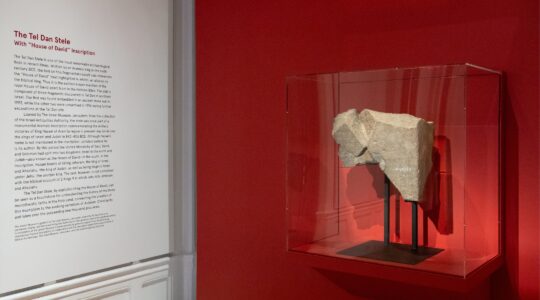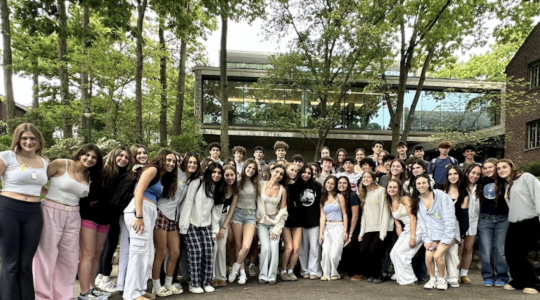After no more than 20 minutes in a Nazi concentration camp, Polish diplomat Jan Karski had to leave. “I couldn’t take it,” he recalled later. Karski, who in 1942 would provide the West with the first eyewitness accounts of Holocaust atrocities after secretly entering the camp and the Warsaw Ghetto, died last week in Washington. He was 86.
“I cried when I read he had died, not just because I had lost a friend but imagine what could have happened if people had listened to him,” said Michael Berenbaum, a prominent Holocaust scholar.
Some who heard Karski’s accounts of the slaughter of Jews found them impossible to fathom, Berenbaum said. He recalled that Supreme Court Justice Felix Frankfurter, a Jew, had told Karski: “Young man, I can’t believe you.” Asked if he doubted Karski, Frankfurter replied: “You don’t understand me. I didn’t say he isn’t telling the truth, I said I can’t believe him.”
Nobel laureate Elie Wiesel described Karski as “very, very special.”
“He saw [President Franklin] Roosevelt, Frankfurter and [British Foreign Minister Anthony] Eden. He was a man involved in history with a capital ‘H.’ ”
The chairman of the American Society for Yad Vashem, Eli Zborowski, said Karski also made an important contribution “as a non-Jew speaking about Polish-Jewish relations [during the Holocaust]. There were some people who were helpful to the Jews, and others who collaborated with the Germans. He felt that by speaking about these events, it would improve Polish-Jewish relations.”
Karski made one of his last public appearances at the United Nations in March when he was honored as one of 65 diplomats from 22 countries — only four of whom were living — credited with saving more than 300,000 Jews during the Holocaust.
“I wanted to be helpful to the Jews, the oppressed people,” Karski said in a later interview with The Jewish Week. “I was very young, idealistic and religious, and I wanted to do as much as I could. I saw terrible, terrible things happening to the Jews. There was poverty, despair — the Jews were treated worse than cattle. You didn’t see them on the streets. They were [confined] to ghettos and concentration camps.”
He said that when he first started working for the Polish Foreign Office, “I was strong and knew Europe. That’s why the Polish Jewish underground used me as a courier, taking messages to the Western allies and begging them to intervene to save the destruction of the Jews.”
Karski, a Roman Catholic, began his work for the Polish Jewish underground in 1939 and became one of its most skilled couriers. “They sent me four times across Nazi-dominated Europe,” he said.
Two leaders of the Jewish underground who had escaped from the Warsaw Ghetto told him of Hitler’s plans to exterminate Polish Jewry; more than 1.8 million already had been murdered, they said. Karski agreed to their request that he secretly enter the ghetto to see what was happening and to tell Western leaders what he witnessed.
In the third week of August 1942, Karski, then 28, was taken to the cellar of an apartment building just outside the ghetto. Wearing ragged clothes and the Star of David, he was led through a recently dug tunnel into the ghetto.
In Claude Lanzmann’s documentary film “Shoah,” Karski recalled seeing naked corpses in the streets, listless children and emaciated people.
From the ghetto, a train took Karski to Izbica, a small town nearby, where a bribed Ukrainian militiaman gave him his uniform and another took him into the concentration camp there.
“When the Nazis deported the Jews from the ghettos, they told them to take whatever they could carry,” he told The Jewish Week. “So they took with them hard currency, jewelry and such. The Nazis would then take them to several transitory camps, where they were told to disrobe and where [the Nazis] took their possessions. I saw it. I saw terrible things — all the people being pushed into cattle trains. And the children — I saw the scene of them being pushed into the train” for transport to the gas chambers.
“I went with my guide, who had credentials and was known in the camp,” Karski said. “I was there no longer than 15 or 20 minutes. I couldn’t take it.”
He returned to Warsaw and was given a “microfilm hidden in a regular house key. It contained a report 30 pages long, yet it was no bigger than a fraction of an American match.”
Karski then spent 21 days traveling to Barcelona, where an American helped him get to London on Nov. 25, 1942. He turned over the key with the microfilm and described what was happening to the Jews, first to his Polish diplomatic superiors and then to British authorities.
In 1943 he was sent by the Polish government in London to the U.S. to inform the American government about the situation in Poland and of the destruction of the Jews.
“On July 28, I was summoned to the White House by President Roosevelt,” Karski recalled. “I told him as much as I was able. He asked me questions on all subjects, and I tried to make the point that a distinction had to be made: that the Nazis wanted to make out of my people — the Poles — a nation of slaves, and that they wanted to destroy all the Jews.”
John Pehle, who was appointed by Roosevelt to head the War Refugee Board, which helped to resettle surviving Jews, said later that Roosevelt created the board as a result of his meeting with Karski.
Pehle said the visit “changed U.S. policy overnight from indifference to affirmative action.”
But Karski believed his mission a failure.
Asked his reaction of Roosevelt, Karski said: “President Roosevelt was one of the greatest men in the 20th century, but he was not a Jewish or a Polish president. He was an American president who was for American interests.”
Karski sought to return to Warsaw, but his superiors told him the Nazis had learned his identity and ordered him to stay in the U.S. to promote the cause of Poland. He became a U.S. citizen and taught history at Georgetown University until his retirement in 1984. He also became an honorary citizen of Israel.
Washington correspondent James D. Besser contributed to this story.
The New York Jewish Week brings you the stories behind the headlines, keeping you connected to Jewish life in New York. Help sustain the reporting you trust by donating today.




